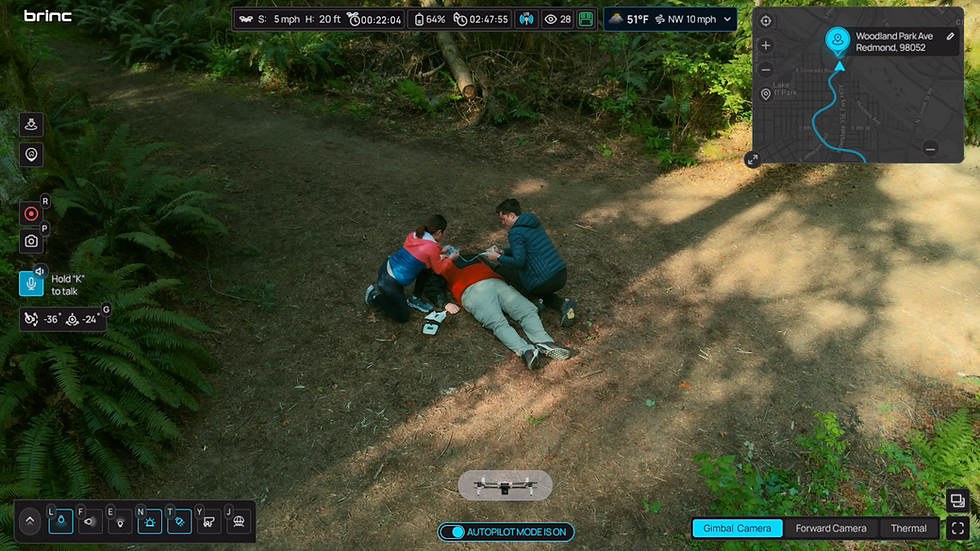What Would The World Miss if BRINC Didn’t Exist?
- Akshata

- Jun 16
- 4 min read

It started with a tragedy.
October 1, the deadliest mass shooting in U.S. history, wasn’t just a headline, it was personal for Blake Resnick, the Founder & CEO of BRINC. A Las Vegas native, Blake had a couple of friends on the strip that day. That kind of moment doesn’t leave you. It pushes you. So he did something.
You can listen to the full story here, but the short version is this:
Blake started riding along with the Las Vegas Metro Police Department. Not once or twice, over a dozen times. Every call, every tense entry into the unknown, revealed one thing: officers were going in blind. There were no tools for the indoor unknown. No eyes inside. No safe way to assess before stepping into chaos.
Those insights led to the creation of BRINC’s first product: the Lemur, an indoor tactical drone built for high-stakes missions.
Before BRINC
In the early days, public-safety teams often had no choice but to modify consumer drones for missions they were never designed to handle. From shaky video feeds to unreliable communication and jury-rigged mounts, these makeshift solutions left responders with more questions than answers. More importantly, there was no such thing as an “indoor tactical drone.” Special Weapons And Tactics (SWAT) and hostage rescue teams were forced to enter situations blind, exposing themselves to lethal risk. BRINC changed that.
The Lemur could slip through tight doorways, breach barriers with a glass breaker, and stream encrypted, stable video directly to command. Suddenly, responders could clear rooms with certainty rather than inch forward into danger. They could gather intel, communicate with suspects or victims, and de-escalate before a single shot was fired.
Why Not Just Use a Consumer Drone?

People ask this a lot. Why not just adapt off-the-shelf consumer drones? Some suggest they’re “overbuilding” by including redundant Long Term Evolution (LTE) radios, hardened frames, and thermal cameras they consider unnecessary. They ask, “Why not just add lights to a hobbyist drone?” and point out that “everyone already owns a DJI.”
But BRINC’s team knows that consumer drones can’t break through a window pane, won’t launch at the push of a dispatch button, and can’t reliably drop an Automated External Defibrillator (AED) to someone in need. By committing to a purpose-built design, BRINC ensures that every feature, no matter how specialized, is there for one reason: to help save lives.
Changing the Industry Conversation
Before BRINC, drones in public safety were passive observers, great for aerial footage, but hardly useful in direct engagement. BRINC turned that concept on its head.
Their drones interact: they break windows, open lines of communication, and deliver payloads. That shift from situational awareness to active intervention sparked a whole new conversation about what drones can and should do in emergencies.
The “Wait, You Saved Us How Much?” Moment
You’d think the biggest wins would be about budget. But for BRINC, the real Return on Investment (ROI) shows up in moments when someone walks away alive.
Time and again, officers have used BRINC’s drones to enter dangerous scenes like active shooter situations, hostile buildings, places where human entry meant unacceptable risk. In some instances, the drones were fired upon and destroyed. But they did their job.
No one said it better than the agency that told BRINC:
"The pilot saw the bad guy on the monitor emerge with the shotgun and fire; the drone went down and video was out but audio kept working because the pilot could hear the bad guy coughing after the crash. I would say the drone performed exactly as designed and took a bullet that might have otherwise hurt someone."
Seamless by Design

One of BRINC’s quietest achievements is also one of its most impactful with zero learning curve. There’s no power button. No complex menu.
Insert a battery and it immediately boots all systems and begins streaming into LiveOps. To talk through it, you just call its number. They are designed to operate as naturally as a standard first responder radio. For officers and dispatchers, it means one less tool to learn and one more they can trust, immediately.
Some Advice for Anyone Building in This Space
We asked David Benowitz, VP of Strategy & Marketing Communications at BRINC, what advice he would give to someone starting in the drone space. His answer was simple: There is no true ‘drone industry.’ We are all trying to provide value for specific users, not just make a beautiful drone. Never lose sight of that.”
What Would the World Miss Without BRINC?
This is the hardest question to answer.
Unfortunately, if BRINC didn’t exist, more first responders and civilians would be dead. That’s not marketing language, it’s a fact repeated in feedback from agencies across the country. BRINC drones don’t just provide visibility, they stand between danger and the people facing it.
And sometimes, they literally take the bullet.



